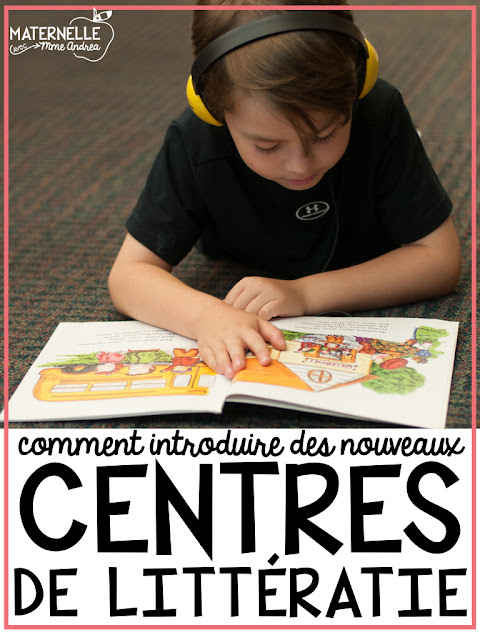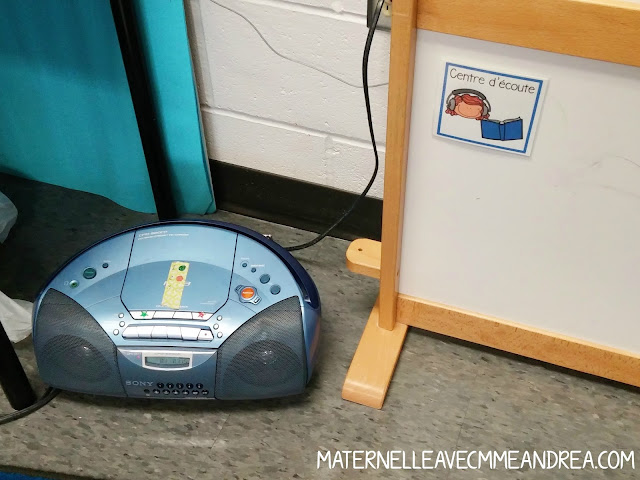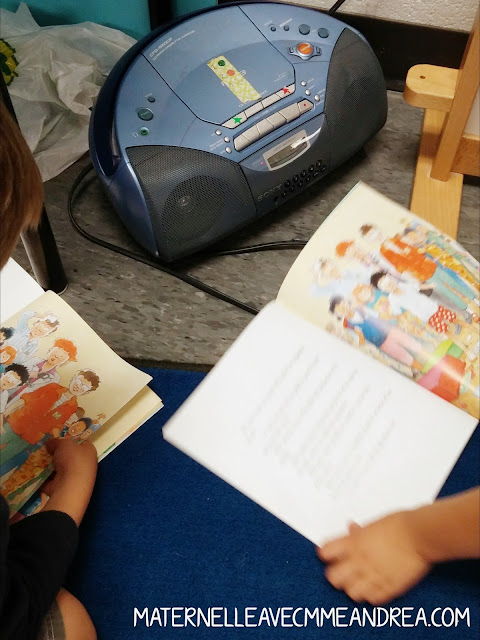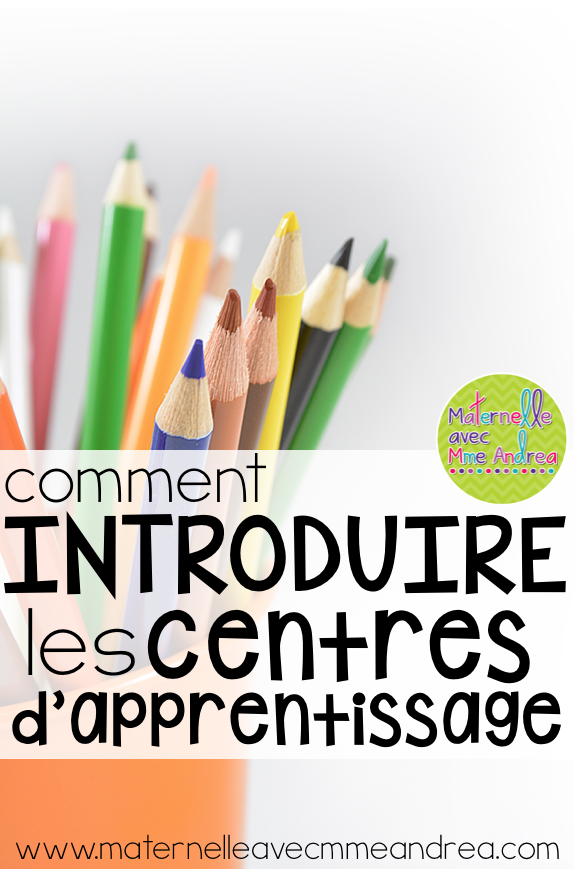Happy Sunday!
It is a rainy day here in NS today – fall has definitely arrived! A perfect day for curling up with a mug of coffee and writing my next post in my centres d’apprentissage en maternelle series. Today I would like to talk to you about my tips for introducing new centres and activities to your primary students.
In my experience, introducing centres and activities GRADUALLY, one activity at a time, is the way to go, rather than trying to switch out all your centres at once every Monday. There are a few reasons for this, including:
– It is WAY less prep that you have to have done all at once
– If you didn’t get everything prepped that you wanted, it’s okay – your students can continue the activity that they worked on last time
– You only have to talk about one activity at a time, so your students only have to pay attention for about five minutes
– It leaves you lots of opportunity to also review with your students
I suggest teaching or reviewing one thing with your students before EACH centre rotation. I always bring my students back to the carpet before each rotation. We can regroup and discuss any necessary reminders, and then I move right into the one thing I want to teach them that day. I do two rotations, so I review/teach them something about centres twice per day.
As I said in a previous post, I start the year with centres that my students already know how to do – things that require no explanation (blocks, Lego, Play Doh, etc.). I teach only behaviour expectations (see this post for more details) and routines (see this post for more details) at this time. Once they are independent and doing what I expect, I add in our “real” centres gradually, once at a time, over the span of a couple weeks.
Which brings me to my first tip!
1. HAVE “CORE” CENTRES
I have 10 “core” centres. 10 centres that we do over and over, all year long. I will be talking about each one in more detail in future posts, but just for an idea, here is what they are:
– Pâte à modeller
– Jeux
– Écouter un livre
– Lecture à soi
– Motricité fine A
– Motricité fine B
– Étampes
– Écris la salle
– Phrases fantastiques
– Écriture
I have eight groups this year, so we can take breaks from a centre at any time students seem to need a break from it. Obviously, we don’t do the exact same things at these 10 centres all year long, but they all have the same main ideas and process, and the behaviour expectations stay the same.
It may sound boring, but trust me – students LOVE repetition and doing what they already know how to do… plus there are a few simple tricks to keep them engaged. For example, Phrases fantastiques is a centre almost all year long (I introduce it in October and it stays until June). But, I change out the themes depending on the holiday/season.
Each them has new vocabulary words and new sight words. I keep the same theme for about two weeks, which allows every group to try it twice. In the second week, I provide them with a mini book with the target sentence in it (included in each set), so if they don’t want to build sentences the second time, they can colour the book to take home and practice instead.
Changing out your activities to match the season/upcoming holidays is a great way to keep your students interested in your “core” centres!
Make sure that you have enough “core” centres for all of your groups, plus a couple extra in case you sense your students need a break from one. It’s up to you how many centres you want to run – I run eight because I like for my students to work in partners. But if I put them in groups of three, I would only need to prep six centres at a time. I used to only run five centres and have larger groups, because that was all that I was able to handle prepping for in my early teaching years. Try to find a balance that works for you and that you can realistically keep up with! Switch them out in a time frame that works for you.
Pro tip – look for bundles on TPT! When you purchase bundles, you usually get enough of one core activity to last you the year, with different examples of that activity for each season/holiday. You can also save a LOT of money by purchasing the bundle, rather than buying each set individually! For example, I always have an EEK! game in our Jeux centre bin. Each is listed for $2.50 in my store and I have 16 different games, but the bundle is only $30 – it’s like getting 4 games free!
Most French sellers on TPT who sell centre activities offer bundles like this.
2. INTRODUCE/REVIEW *ONE* THING BEFORE EACH ROTATION
I know I said this above, but I feel that it is really key to smooth centre blocks! This time before each rotation is so valuable – your students are fresh and ready to listen, and then can put into practice what you say right away. By just talking about one thing, you avoid the glazed-eyes look from over half your class. In the beginning of the year, take this time to gradually introduce your core centres, and steer them away from the free play centres. Of course, your centres should still seem more like play than work, considering our clientele! For example, last week, I showed my students how to make letters out of Play Doh and spell their names, and introduced Écris la salle (we just have been walking around the room writing letters and names that we know). I also introduced our first EEK game (EEK! Ver de terre!), but kept our previous games in the bin in case not all groups are ready to try it out yet. The week before, I introduced Écouter une histoire and how to use the stereo.
Another great thing to do during this time is to co-create your référentiels. I do not offer any centre anchor charts in my TPT store, because I truly believe that you should create them with your students. It works well to make an anchor chart of your job/their job during the mini lesson part and the practice part of each centre block, as well as one for behaviour expectations of each core centre. You can review these anytime that your students’ behaviour gets off track.
3. EXTEND YOUR CENTRES… TAKE THEM TO ANOTHER LEVEL!
One way to ensure that your core centres remain engaging is to have them grow in difficulty with your students’ abilities. In the beginning of the year, my centres have a lot to do with reviewing letter names (only those that we have learned as a class). Later on, I will gradually add the sight words that we learn to the mix. I will push my students to do more as they become capable of doing more.
Check out how I gradually teach Écouter un livre as an example:
Lesson 1 –This is my stereo…here is how you can use it to listen to a story (push the green button to start and the red to stop) (I provide the books and I have the stereo already all set up.
Lesson 2 – This bin is where you can find and clean up the books for Écouter un livre.
Lesson 3 – I have added some blank white paper and markers to the bin. Once your story is over, try drawing me a picture of your favourite part!
Lesson 4 – Here is where I would like for you to put your picture of your favourite part when it is time to clean up. Don’t forget to add your name!
Lesson 5 – I love all of the pictures you have all drawn of your favourite parts, but we have been listening to so many books that I am getting a little confused! Let’s use this paper now. Here is a box for you to write the title and a spot for you to add your name.
Lesson 6 – Did you notice these lines on the bottom of the page? You guys are such great writers now – why don’t you try writing about your favourite part as well?
Obviously, I don’t teach all of those six lessons in the same week! The last one especially will have to wait until awhile later in the year. You will know when your students are ready for each step. I also switch out the book once everyone has listened to it, and review my expectations/pump them up for the new book before each switch. Since I have eight groups, each book usually lasts about a week. I have spent many Scholastic bonus bank dollars building up my listening library! I also reuse some of the first books we listen to at the end of the year…it is neat for your students to see how far they have come by comparing their writing about the same book at the beginning and the end of the year.
If you would like to use the same recording sheet as I do for Écouter un livre, you can get it for free in my FREE French Resource Library!
If you’re not currently a member, just CLICK HERE, enter your info, and I will email you the password.
Check back again next week, when I will share with you how another of my core centres looks and how I keep my students excited about it all year long!
Pin for later:









